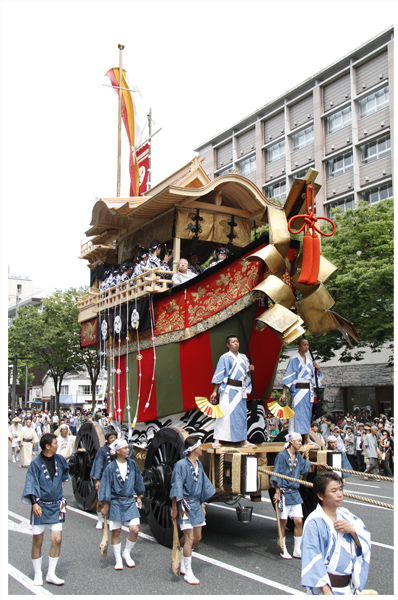後祭の鬮とらずとして後祭、11基の山鉾の殿をつとめる。500年余りの歴史を持ち、江戸時代の再三の大火に被災するもそのつど復興を繰り返してきたが、幕末の元治元年(1864)におこった「蛤御門の変」にて屋形・木組・車輪等を失い、それ以来巡行参加することはなかった。長い年月を経て平成9年にお囃子の復興、そして焼失を免れた神功皇后の御神像や舳に飾る大金幣、また織物・刺繍の高度な技術を駆使して製作された大舵や水引・前懸・後懸等をお飾りしての「居祭」の再開で復活への機運が盛り上がり平成24年から唐櫃巡行を、そして平成26年四条町の皆様の熱意と多くの方々のご協力のおかげで150年ぶりに巡行参加することが出来た。この年より祇園祭も前祭・後祭の巡行が17日・24日と49年ぶりに分離巡行となった。舳先には江戸期に現存していた大金幣と近年完成した龍頭を隔年でつけて巡行している。
ŌFUNE HOKO performed the role of the final position in the procession of the last festival, exempted from the lottery, called Gaisen Funehoko‐returning in triumph, while FUNE HOKO in the first festival called Shutsujin Funehoko‐going into battle.
The float has its origin more than 500 years ago. It has been absent from the procession since losing its house frame, wooden structure, wheels and so forth in the Hamaguri Gomon Incident in 1864, although it had been revived several times against suffering from the big fires through the Edo period.
After passing many years, in 1997, hayashi - the float orchestra revived and Ōfune Hoko resumed as “Imatsuri”, not joining the procession, displaying with the figure of Empress Jingū which had escaped from the fire, the big gold strips decorating at the bow, and the great steering wheel, mizuhiki, maekake, ushirokake and others produced by using high technique of fabric and embroidery.
That brought a great opportunity for revival. In 2012 Ōfune Hoko “Karabitsu” style procession began, and finally in 2014, with the enthusiasm of Shijo-cho residents and the support of many people, it joined the procession after 150 years’ absence.
公式サイトはこちら




